Khachkar
A khachkar, also known as an Armenian cross-stone[1] (Armenian: խաչքար, pronounced [χɑtʃʰˈkʰɑɾ], խաչ xačʿ "cross" + քար kʿar "stone") is a carved, memorial stele bearing a cross, and often with additional motifs such as rosettes, interlaces, and botanical motifs.[2] Khachkars are characteristic of Medieval Christian Armenian art.[1][3]
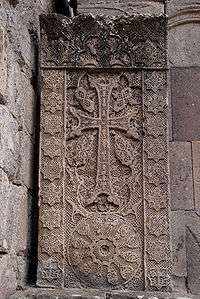

Since 2010, khachkars, their symbolism and craftsmanship are inscribed in the UNESCO list of Intangible Cultural Heritage.[4]
Description
The most common khachkar feature is a cross surmounting a rosette or a solar disc. The remainder of the stone face is typically filled with elaborate patterns of leaves, grapes, pomegranates, and bands of interlace. Occasionally a khachkar is surmounted by a cornice sometimes containing biblical or saintly figures.
Most early khachkars were erected for the salvation of the soul of either a living or a deceased person. Otherwise they were intended to commemorate a military victory, the construction of a church, or as a form of protection from natural disasters.[5]
The most common location for early khachkars was in a graveyard. However, Armenian gravestones take many other forms, and only a minority are khachkars.
History
The first true khachkars appeared in the 9th century,[1] during the time of Armenian revival after liberation from Arab rule. The oldest khachkar with a known date was carved in 879 (though earlier, cruder, examples exist). Erected in Garni, it is dedicated to queen Katranide I, the wife of king Ashot I Bagratuni. The peak of the khachkar carving art was between the 12th and the 14th centuries. The art declined during the Mongol invasion at the end of the 14th century. It revived in the 16th and 17th centuries, but the artistic heights of the 14th century were never achieved again. Today, the tradition still remains, and one can still see khachkar carvers in some parts of Yerevan.[6]
About 40,000 khachkars survive today. Most of them are free standing, though those recording donations are usually built into monastery walls. The following three khachkars are believed to be the finest examples of the art form:
- One in Geghard, carved in 1213, probably by master Timot and master Mkhitar
- The Holy Redeemer khachkar in Haghpat (see gallery), carved in 1273 by master Vahram
- A khachkar in Goshavank, carved in 1291 by master Poghos.
A number of good examples have been transferred to the Historical Museum in Yerevan and beside the cathedral in Echmiadzin. The largest surviving collection of khachkars is in Armenia, at Noraduz cemetery on the western shore of the Lake Sevan, where an old graveyard with around 900 khachkars from various periods and of various styles can be seen. The largest number was formerly located at Julfa in the Nakhichevan Autonomous Republic of Azerbaijan, but the entire medieval cemetery was destroyed by Azeri soldiers in 2005.[7]
Present
The art of carving khachkars has witnessed a rebirth as a symbol of Armenian culture in the 20th century.
There are hundreds of khachkars worldwide, many of which are memorials to commemorate the victims of the Armenian Genocide. Khachkars have been placed in various locations, including at the Vatican Museums,[8][9] Canterbury Cathedral's memorial garden,[10][11] St Mary's Cathedral, Sydney,[12][13] Colorado State Capitol,[14][15] Temple of Peace, Cardiff,[16] Christ Church Cathedral, Dublin,[17] and elsewhere.
According to one count, there are nearly 30 khachkars on public locations in France.[18]
Armenian khachkars have been acquired or donated to many museums or temporarily represented at significant exhibitions all around the world such as at the British Museum, the Metropolitan Museum of Art or the Special Exhibition of the National Museum of Ethnology, Osaka, Japan.[19]
Endangered khachkars
A large portion of khachkars, which were created in historic Armenia and surrounding regions, in modern times have become the possession of Turkey, Azerbaijan, and partly Georgia and Iran. As a result of systematic eradication of khachkars in Turkey, today only a few examples survive. Unfortunately these few survivors are not cataloged and properly photographed. Thus, it is difficult to follow up with the current situation.[20] One documented example took place in the Armenian Cemetery in Jugha.[21][22][23]
One source says that khachkars are being damaged, neglected, or moved in Armenia.[24] Reasons cited for moving these khachkars include; decoration, to create new holy places, or to make space for new burials.
The government of Azerbaijan has denied claims that members of the Azerbaijani Armed Forces smashed khachkars with sledgehammers in Nakhichevan in December 2005.[25]
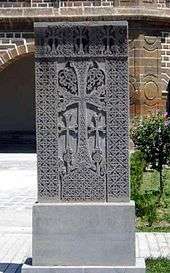
Types
Amenaprkich (Armenian: Ամէնափրկիչ, meaning Holy Saviour) is a particular type of khachkar in which on the cross is a depiction of the crucified Christ. Only a few such designs are known, and most date from the late 13th century.
Gallery
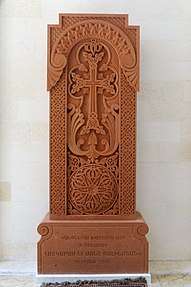 A modern khachkar at Sourp Kevork church- Beirut, Lebanon (2016)
A modern khachkar at Sourp Kevork church- Beirut, Lebanon (2016)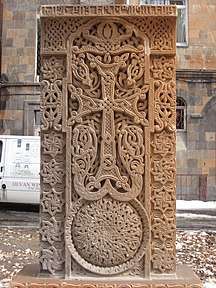 in Gyumri
in Gyumri- Khachkar at Haghartsin Monastery, near Dilijan, Armenia.
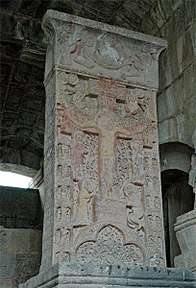 The Holy Savior khachkar in Haghpat (1273)
The Holy Savior khachkar in Haghpat (1273)- Various khachkars at Makaravank Monastery in Armenia
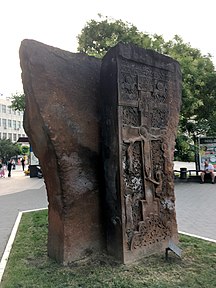
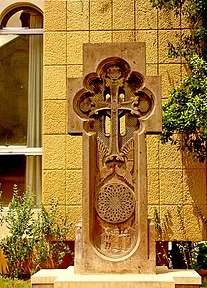 A modern khackhar at the Armenian Catholicossate of Cilicia in Antelias, Lebanon
A modern khackhar at the Armenian Catholicossate of Cilicia in Antelias, Lebanon
See also
| Wikimedia Commons has media related to Khatchkars. |
- Trei Ierarhi Monastery - a 17th-century church in Iași, Romania, decorated with Khachkar motifs
- High cross - Monumental Celtic crosses.
- Preaching cross - Monumental crosses used as open air pulpits
- Hill of Crosses - A hill in Lithuania covered with ornamental crosses.
References
Citations
- The Grove Encyclopedia of Medieval Art and Architecture. — Oxford University Press, 2012. — Vol. 2. — P. 222."'Khatck'ar' [Armen.:'cross-stone'] Typical Armenian stone monument, comprising an upright slab (h. c. 1—3 m) carved with a cross design, usually set on a plinth or rectangular base. "
- Thierry, cover sleeve.Thierry 1989
- Gough M., The Origins of Christian Art, London, 1973
- "Armenian cross-stones art. Symbolism and craftsmanship of Khachkars". UNESCO Culture Sector. Retrieved 2010-11-20.
- "Armenian Khatchkars" (Editions Erebuni, 1978)
- Anatoli L. Yakobson. Armenian Khachkars, Moscow, 1986
- "Tragedy on the Araxes". Archaeology. 2006-06-30. Retrieved 2006-06-30.
- "Medieval Armenian cross-stone unveiled in Vatican". aysor.am. 20 September 2014. Archived from the original on 2 July 2019.
- "The story behind the Medieval Armenian Cross that's now in the Vatican Museums". ROME REPORTS in English. Mar 29, 2015.
- "The Canterbury Khachkar: A Historic Day in the Heart of the Anglican Church". Asbarez. March 6, 2019. Archived from the original on 4 April 2019.
- "1st Armenian cross-stone dedicated to memory of Armenian Genocide victims unveiled in Great Britain's spiritual center". Armenpress. 5 March 2019. Archived from the original on 5 March 2019.
- Rodrigues, Marilyn (December 19, 2018). "Armenian monument unveiled at cathedral". The Catholic Weekly.
- "Armenian khachkar unveiled at Sydney's St. Mary's Cathedral (PHOTO)". 18 December 2018. Archived from the original on 21 June 2019.
- "Colorado Governor Unveils America's First State Capitol Khachkar". Asbarez. May 15, 2015.
- "Colorado Governor Unveils First State Capitol 'Khachkar' on Genocide Centennial". The Armenian Weekly. May 15, 2015. Archived from the original on 2 May 2019.
- "The Armenian Genocide Monument in Wales". armenian-genocide.org. Armenian National Institute. Archived from the original on 28 February 2019.
- "Service of Remembrance" (PDF). The Armenian Church & Community in Ireland. April 2017. p. 3. Archived from the original (PDF) on 14 November 2017.
In December 2015 we unveiled the Khachkar Memorial (Stone-Cross) in Christ Church Cathedral in Dublin in remembrance of the Armenian Genocide “MEZ YEGHERN” and in dedication to the massive destruction that took place 102 years ago.
- "Toponymie et Monuments arméniens". acam-france.org (in French). Association Culturelle Arménienne de Marne-la-Vallée (France).
- "Khachkar (Stone Cross)".
- Der Nersessian S. Armenian Art, Paris, 1978.
- "Azerbaijan: Famous Medieval Cemetery Vanishes". Caucasus Reporting Service, Institute for War and Peace Reporting. April 19, 2006. Retrieved 2007-04-15.
- "World Watches In Silence As Azerbaijan Wipes Out Armenian Culture". The Art Newspaper. 2006-05-25. Retrieved 2006-05-25.
- "Tragedy on the Araxes". Archaeology. 2006-06-30. Retrieved 2006-06-30.
- "Endangered Khachkars". Khachkar.am. Retrieved 2012-05-06.
- Castle, Stephen (2006-05-30). "Azerbaijan 'flattened' sacred Armenian site". Belfast Telegraph. Archived from the original on 2018-05-14. Retrieved 2018-05-14.
Other sources
- ^ Thierry, Jean-Michel (1989). Armenian Art. New York: Harry N. Abrams. ISBN 0-8109-0625-2.
External links
- Armenian cross-stones art. Symbolism and craftsmanship of Khachkars
- Khatchkar collection at Armenica.org
- Old Jugha page on Armeniapedia
- Destruction of Jugha khachkars by Azeri soldiers captured in photos and movie clips.
- Khachkar page on Armeniapedia (many photos)
- Photos at Armenia Photos.info
- Photos of 15th/16th CE khatchkars near Bitlis, Turkey
- Khachkar.am :: Everything about khachkars
- Photos and history of Khachkars
- Djulfa Virtual Memorial and Museum
- Largest facebook page dedicated to Armenian Cross-Stones (Khachkars)